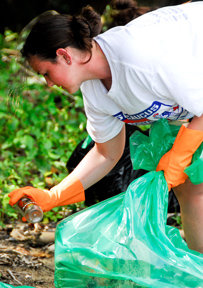Despite the sub-freezing temps and lingering snow from last week’s blizzard, many college students are already planning for Spring Break.
Some will catch up on lost sleep or try to earn a few bucks, while others will party on the beach. But in recent years, a trend called “alternative break” has gained traction among many civic-minded students. First popularized in the 1980s, it allows students to participate in good works and volunteer activities during their spring or winter vacations.
Although students can do an alternative break on their own through a community or nonprofit group, many colleges now offer their own structured alternative break programs.
“We wanted to make it look better and make it a place where kids would want to go and stay longer.” – Courtney Waters
________
“The location appealed to me. We have a [study abroad] program here that goes to Wroxton, England, for a semester, and that’s typically all you hear about,” she said. “So seeing Costa Rica was a different opportunity that I wanted to take advantage of.”
Waters was among 11 college students who went to Manzanillo, Costa Rica, to help renovate a four-room elementary school. Manzanillo is located on the Caribbean coast, north of the Costa Rican border with Panama.
“Most of the children only get through the sixth grade,” she explained. “By law you only have to finish either sixth or ninth grade. And a lot of kids there do what’s required and don’t go any further. Just from looking at the school, you can see why kids don’t want to stay there. The way that it looked, I wouldn’t want to go to school there. So, we wanted to make it look better and make it a place where kids would want to go and stay longer.”
When the college students arrived in Manzanillo, where it frequently rains, they were faced with flooded classrooms and pane-less windows that were covered with gray bars.
“And this would be in spots where kids would be seated,” Waters said. “So it was possible for kids to be going through their day and getting wet in the classroom.”
Despite having one of the strongest economies in Latin America, Costa Rica still suffers from high rates of unemployment and poverty, and few poor people are able to pursue higher education.
To improve conditions, the college students helped rebuild a bathroom, cleaned trash and other debris from the land outside the school, and painted two classrooms and window bars during their 10-day project. Working closely with Dennis Clark, who heads up a local development organization in Manzanillo, they also did some landscaping outside the school. A local architect also helped guide the work.
The college students didn’t receive any direct feedback on their work from local students and teachers since Costa Rican schools have an academic break in January. But “we had a lot of interaction with other locals,” Waters said. “We actually got a few of them to come down and help us out. And I know they were very appreciative of everything that we did.”
Program gets expanded
This was the first year that Fairleigh Dickinson expanded its alternative break program outside the U.S. Last year 22 students from the university traveled to New Orleans to help in the ongoing rebuilding effort there in the wake of 2005’s Hurricane Katrina. That successful alternative break effort encouraged the university’s Student Government Association to offer three similar trips in 2010.
In addition to January’s winter break trip to Manzanillo, Fairleigh Dickinson students will again travel to New Orleans and also do some volunteer work in Arizona over spring vacation.
“I would definitely recommend it to other students,” said Waters, a biology major/Spanish minor who eventually plans to attend medical school. “I think for a lot of people it would give them an opportunity to experience other cultures and go to different places if you’re not able to do a full semester abroad.”
The 2006 Secaucus High School grad said she didn’t do much volunteer work in her pre-college days, although she was an active athlete and was president of her class throughout high school.
Since attending Fairleigh Dickinson, she has become active in raising money for the American Heart Association and the American Cancer Society through her sorority, Theta Phi Alpha.
E-mail E. Assata Wright at awright@hudsonreporter.com.
